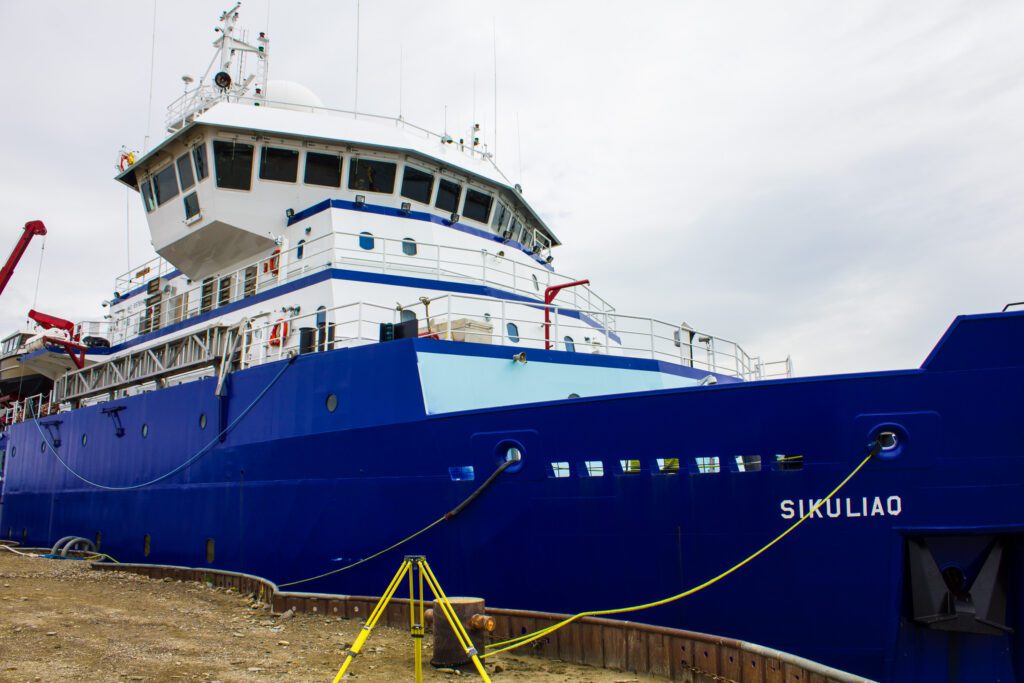For the first time in more than 20 years, the Tiglax is sailing up to Cape Thompson to look at seabird populations. The Tiglax is a 120-foot research vessel owned by the Alaska Maritime National Wildlife Refuge (AMNWR).
The Tiglax (pronounced “TEK-lah”) takes its name from the Aleut word for “eagle.” And like an eagle, it covers vast stretches of Alaska, visiting refuges from Safety Sound and Topkok to Sitka Sound, from Cape Lisburne to the Pribilof Islands. AMNWR was formed in 1949 by consolidating dozens of smaller refuges throughout the state.
But voyages to the Northern regions are rare. Slow-moving vessels, small research teams, and cost make it difficult to study in the northern Bering and Chukchi Seas. The last trip to Cape Thompson was in 1995. The Homer-based crew set sail from Nome on Monday night, July 30. Heather Renner, the supervisory biologist for AMNWR, explains their plan for study in Cape Thompson.
“This is the closest port to Cape Thompson and Cape Lisburne that isn’t too shallow for our ship to get into. We’re going to go see the condition of the seabird breeding cliffs. There are plots there that were established a long time ago, some of them as early as 1959; we’re going to go take pictures of all those population plots and, if we can, of the whole cliff area, so we can count birds on there.”
They hope to monitor the size of the population and get an idea of breeding success. Seabird die-offs have been observed all around the state. The Tiglax will also stop at Sledge Island to make observations there.
This year, Renner says mean temperatures in the Bering Sea have been about four degrees warmer than usual and sea ice levels were extremely low.
“As everybody is painfully aware, the effects of climate change are more pronounced in the North than they are in other parts of the state.”
The warmer temperatures and low sea ice are causing changes in the ecosystem that scientists don’t yet understand, including recent seabird die-offs. Necropsies on birds around the state show that the birds are starving. Sea bird die-offs in the past have been related to warm water. Renner shared some popular hypotheses, which included prey redistribution and a change in the quality of the prey itself:
“Fish or plankton just go a little bit deeper to where birds can’t reach them or it can change the quality of the prey. We know in warm years that the plankton composition is different. They tend to be different species, and those tend to be less fatty, less lipid-rich, things that are less good for seabirds.”
It isn’t just seabirds in trouble. Reports of dead or emaciated fish and marine mammals are coming in from around the state. The AMNWR researchers found a dead whale in Safety Sound on Monday.
The situation has necessitated more communication not only between scientists, but also community members.
“The seabird die-offs we’ve been having recently — one good thing I’ll say is that they’re teaching us how to partner and how to collaborate… lots of people in communities that are sending in reports from communities around the whole state are helping us to understand what’s going on and how to put the story together.”
While the team won’t have any conclusions following this trip, they will be looking for places to set up camp in Cape Thompson for the future. This would allow for more research trips and more data.
The Tiglax will be returning to the Port of Nome on August 10.
Image at top: file photo: public domain, via Pixabay.







